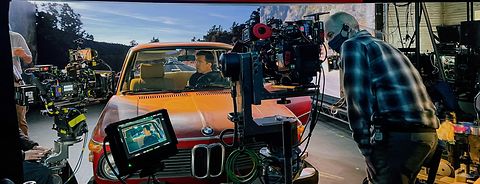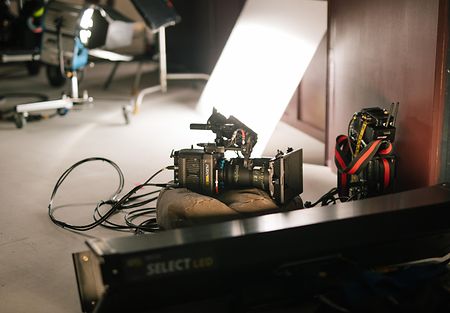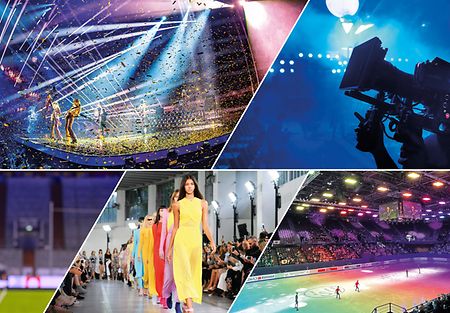The evolution of film formats through cinema history has been driven by the search for visual and emotional impact. Today’s aspect ratios are rooted in the film industry’s move to wider screens in the 1950s, partly a response to the advent of television. But it’s not just the shape of the frame that gave “Lawrence of Arabia” and “Ben-Hur” their epic sweep. Formats often bring their own unique lens architecture, depth of field, and other distinctive optical traits. Today’s filmmakers are wielding these tools in every type of image storytelling.
“Rutherford Falls” is a perfect example. The half-hour sitcom for Peacock was shot on ARRI ALEXA Mini LFs by director of photography Ross Riege (“Grey’s Anatomy,” “The Catch,” “Queen America”). It’s a comedy in which two lifelong friends find their bond threatened when a conflict involving the statue of an ancestor divides their small town. Ed Helms and Jana Schmieding star, and Michael Schur, known for his work on “The Office,” “Brooklyn Nine-Nine,” and “Parks & Recreation,” is one of the creators.
During prep, Riege worked closely with director Lawrence Sher, ASC, who won an Oscar in 2019 for his large-format cinematography on “Joker.” Sher directed the first three episodes. Riege says that both filmmakers independently saw the project framed in a large format, even though it’s technically a half-hour sitcom – historically a format in which visuals get less consideration.
“I pitched large format from the get-go,” says Riege. “I said I would be interested in doing it if we could shoot it differently than you would typically shoot a comedy. That was built into my mindset. Fortunately, the producers were interested, and asked what that would mean. Eventually, Larry and I started talking, and he had come to the same conclusion. We were passionate, and the producers were supportive, so we went full steam ahead with large format.”
Conversations often referred to David Lynch and Coen Brothers comedies like “Fargo,” “A Serious Man,” and “Burn After Reading.” “In those films, there’s always the right place to put the lens when framing a character,” says Riege. “Often what we were responding to was getting the camera physically closer to the characters.
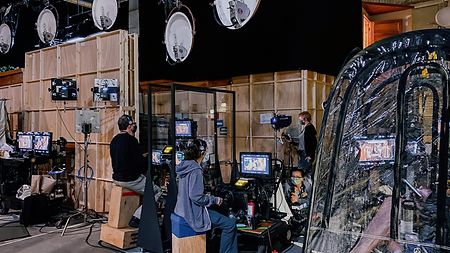
“Rutherford Falls” was shot entirely during the pandemic which required significant COVID protocols on set.
“Another advantage of the larger format was that we could be on a longer focal length lens, but still have a wider frame,” continues Riege. “With a smaller format, you end up having to use comparatively wider lenses. In large format, we could be on a 40 mm and get the face in the right size, but also get the environment around them. Bringing the camera closer to our subjects helped us push more depth into the images – and we’re already at an advantage there with the large sensor. We could get physically closer to the actors without compromising and distorting faces and making it look wacky like it might on 21 mm lens in a smaller format. We still did some longer lens shots, but it's really about the characters and the spaces that they inhabit.”
Riege notes that the time and budget constraints of episodic production must be factored into these decisions. “People say that comedy plays best in the wides,” he says. “But there's a real temptation to just throw on long lenses, go over the shoulder and bang it out. We gave a lot of thought to choosing the right focal length. Can we get both sizes by physically moving the camera closer, rather than making it a zoom show? To be able to do a wide shot and still feel that depth is an incomparable advantage in several ways.”
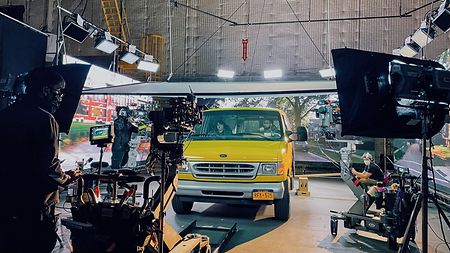
In addition to leveraging large format, Riege also employed virtual production sets for the driving sequences.
The 10-episode shoot was initially put on hold due to the pandemic, and after restarting in September 2020, lasted around 13 weeks. About 65% was done on stages – more than was originally planned. The primary lenses were MasterBuilt Classics. The aspect ratio was 2:1. The Mini LF offers a 4448 by 3096 array of photosites, making it a 4.5K sensor.
The project required a significant amount of LED screen projection, provided by Background Images. “The walls were built with 20”x20” Unilumin 2.6 mm tiles grouped together to form the full screens,” says Riege. “We built a few variations depending on the setups, but in one instance we had an 8’x32’ wall with another 8’x16’ floating wall on wheels, so it could be adjusted to camera as needed. They were able to use up to nine separate HD driving plates that we chose based on scenes, time of day, and scripted location. I supplemented above the screens with a horseshoe of SkyPanel S60s and some tungsten heads on a gag to mimic the background plates. The process is a little bit backwards since the LED plates really determine the lighting base, and I added lighting accordingly to accentuate.”
A wide array of environmental material, often involving driving scenes, was fine-tuned and complemented by Riege’s lighting. “SkyPanels are a real workhorse for me,” he says. “The light quality is clean even at extremely low levels, and they’re so versatile. I use them to key, to run effects gags, and to bounce into the ceiling for room tone. We rig them in condors for night exteriors. The list goes on and is ever-growing. The quick setup, remote adjustability, and low heat impact was especially handy during the pandemic, when we were trying to maintain more space on the set without compromising.”
After finishing “Rutherford Falls,” Riege went back to “The Walking Dead: World Beyond,” which is done in a completely different style – anamorphic lenses, longer focal lengths, and a grungier, less saturated tone.
“It’s the right look for that show, and every project calls for its own approach,” he says. “But after my experience on ‘Rutherford Falls,’ I don’t see a lot of reason to go back to standard format unless I’m forced to. There’s just something about the depth in large format. It’s really hard to say it’s not elegant. I’ve shot medium format stills since I was in college. Now, we’ve gotten to the point where we can do that in cinema and TV. We knew we could play with close focus, something I really missed on ‘Walking Dead.’ We could shoot wide open. And when we designed the look of ‘Rutherford Falls,’ we designed it to some extent around the technology, giving us the ability to maximize and embrace the capabilities that were in our hands.”
“Shooting in larger, full-format should no longer be reserved for big movies like ‘Joker,’” says Riege. “In my opinion, it's inevitable that it's going to become the standard. There's no reason that this can't be a tool in showing comedy in a new way, and I’m glad this project gave me the chance to get a jump on that.”
